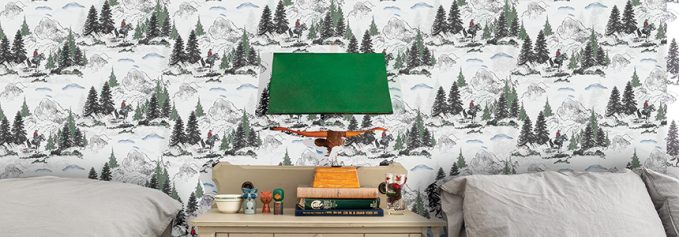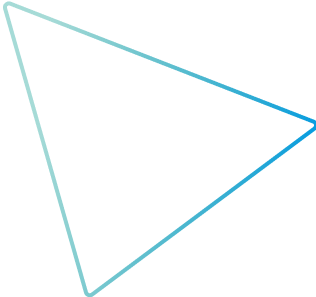
Beyond traditional display and graphics work, savvy businesses capitalize on the limitless opportunities digital print offers. Over the past ten years, Chasing Paper carved out a niche, offering high-end printed wallpaper with modern, classic designs. A variety of which are available in both removable peel-and-stick and traditional wallpaper.
In 2012, siblings Elizabeth and Mike Rees, founders, Chasing Paper, realized the décor potential for printing. At the time, the third-generation print professionals were working for the family business, Kubin-Nicholson. Kubin-Nicholson is a full-service grand format printing company based in Milwaukee, WI.
Elizabeth Rees worked out of the company’s NY division, primarily focused on point of purchase and display projects. “I was becoming more familiar with the equipment side and trying to find a way to make a living outside of the family business,” she shares.
An idea struck while decorating her NY apartment. Wasn’t there a better way to update walls that wasn’t labor intensive, permanent, or damaging to the wall surface? Back in 2012, this wasn’t being done effectively. “I tested and tried everything out, taking projects for friends, and building up the concept. I launched Chasing Paper with my brother in 2013. We were very quickly off to the races,” she recalls.
Originally, it started under the umbrella of the Kubin-Nicholson print brand until the sister and brother duo purchased it. While Chasing Paper is now a separate entity from its former parent company, it still contracts Kubin-Nicholson for production. “We grew up with the people that work there. We have an office and a member of our team is there almost every day,” shares Elizabeth Rees.
Although it all began in NY, the business moved back home and now operates out of Milwaukee where a staff of four is employed.
Above: For Chasing Paper’s peel-and-stick offerings, three working sizes are available—2×4, 2×8, and 2×12 feet; for its traditional offering, two working sizes are available—2×8 and 2×12 feet.
Modern Walls
It turns out; people were interested in easy-to-install, thoughtfully designed wallpaper. Many of its stand-out designs are a result of collaborations with up-and-coming artists. “I am not a designer by trade or education, but I do have a great appreciation for it. From the beginning, we partnered with emerging artists that wanted to build their brand. It was a win-win because we mutually benefited from platform growth,” says Rees.
Today, the company has an impressive selection of designs available on its website, and aims to launch four to six new collections a year. The idea is to have a rotating stock of products that speak to different tastes. “Every time you visit our website, we want you to see something new and attractive. We have a diverse grouping of prints and patterns and hope to have something for everyone,” she explains.
For example, the company just launched its Max Humphrey Collection. Recognized as a design change-maker, based in Portland, OR, Max Humphrey is an interior designer, art director, and product designer. His trademark lived-in, layered look has earned accolades, including being named “Next Wave” designer by House Beautiful and one of Country Living’s 100 most creative people.
Chasing Paper also finds ways to collaborate with like-minded companies such as Pehr, a décor company. Together, the companies offer a one-stop shop for modern nursery designs and products.
Print, On Demand
Chasing Paper prints everything on demand. This allows for operating with lower overhead costs. It also enables it to offer an array of designs, all of the time, and continuously debut new ones.
“It’s a great business model and keeps us lean, flexible, and nimble,” admits Rees. This was especially important the past two years during COVID-19, enabling the company to only carry what was necessary.
Another benefit of digital print is the ability to take the leap when it comes to new technologies. “Making moves for a small business is scary, but with digital the CAPEX is not as steep as buying a $900,000 lithographic press. The downside is that the technology is changing so quickly, as soon as you install your printer it is old. We want to be at the forefront of technology.” she notes.
With digital print capabilities, it is also able to produce samples using the same materials and printers as the final product, leaving little room for surprises.
Over the Summer, the company transitioned from latex to a special UV technology from Canon Solutions America, UVgel. These inks were developed to meet major indoor emissions certifications, such as AgBB and full GREENGUARD Gold.
It found the move successful, noting that the color consistency is reliable even as production has picked up.
The sizing of the panels is a big part of the product. The company was one of the first to offer panels. “I wanted to be able to do this myself, and working with a 20-foot piece of stock and having to cut and trim it didn’t seem like the best way,” says Rees. Shorter panels were the answer. It meant a lot less waste as well as easier and faster installation.
For its peel-and-stick offerings, three working sizes are available—2×4, 2×8, and 2×12 feet; for its traditional offering, there are two working sizes—2×8 and 2×12 feet. Each same-size panel is identical, and as long as each panel is orientated the same way, they line up with one another on all four sides.
The peel-and-stick product is designed to be simple enough for DIY installers, while the traditional paper takes more skill.
Media Matters
Another differentiator is its media. Instead of the vinyl peel-and-stick many removable wallpaper offerings are printed on, Chasing Paper opts for fabric-based, peel-and-stick options in addition to traditional wallpaper.
Fabric media creates a higher end look and feel, a tactile difference from standard vinyl offerings. “We tried everything out when we first started. Everything was shiny vinyl that smelled cheap and damaged the walls. I wanted ours to look more like traditional wallpaper with a texture and grain. The fabric gives a high-quality look, which supports the higher price point,” comments Rees.
She feels this really makes a difference when it comes to comparing the product against the competition. That tactile experience helps potential buyers accept a higher price point.
The peel-and-stick option uses a low-tack adhesive. The company suggests adhering it to walls with premium eggshell, satin, or semi-gloss paint, noting that matte finishes can be trickier as the adhesive can bond and pull the paint.
Pandemic Pivot
Chasing Paper offers many options for residential customers through its ecommerce space. However, it also supports commercial work. Where its residential orders are mostly low touch, commercial projects are high touch. One to two members are on a project to manage custom designs, size, and pricing.
When the pandemic hit in early 2020, Chasing Paper’s commercial revenue was a third of the business and growing. That all went away quickly. Luckily, due to the nature of the business and the effect of the pandemic lockdowns, the company was able to pick up substantial orders in the residential segment to make up for lost revenue on the commercial end.
“We weren’t sure if it would come back in 2021, and in the last quarter and entering 2022 we’ve seen it return. Hospitality businesses, restaurants, and bars are getting back to normal. Wallpaper is a huge trend everywhere and it translates to commercial trends,” explains Rees.
It also fought to stay on top of supply chain issues throughout the ongoing COVID-19 pandemic, proactively assessing the situation and coming up with A, B, C, and D plans to avoid any snags. The company sources all of its materials in the U.S., proving to be an advantage.
Disrupting Décor
With a background in print, an eye for design, and a marketing mind that serves millennial and centennial taste, Chasing Paper has a lot going for it. The company’s print on demand model helps keep overhead low and design options high for buyers. It also makes it nimble, so it is easy to shift focus when events like a pandemic change product demand overnight.
Original article: https://digitaloutput.net/disrupting-decor/
By Cassandra Balentine






